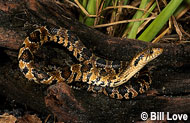Description:
The False Water Cobra, is rear-fanged, with the venom potency unknown. It is often referred to by hobbyists by the acronym of FWC and vernacular of Brazilian smooth snake, is a large, attractive, but nervous colubrine. Defensive FWCs spread a narrow hood, thus the origin of the common name. Despite the fact that very little is known with certainty about the venom of the FWC it has been demonstrated that a good solid bite from this rear-fanged snake can cause some necrosis as well as considerable edema, tenderness and pain. Although these snakes are not usually prone to bite, they should still be handled with caution and respect. This is an active, alert and shy snake. It should be provided with a large terrarium containing a hide-box and assorted visual barriers (such as cork bark or sterilized drift wood). One or two babies may be temporarily housed in a 20 gallon capacity terrarium. A pair of adults should be housed in a 50 to 125 gallon capacity terrarium. In a small terrarium this snake is more apt to abrade its nose than if it is in a large tank. They climb little if at all. Cypress, fir, aspen chips or bark shards are excellent choices for a substrate. A temperature of 78 degrees Fahrenheit at night and 85 degrees during the day is ideal for these snakes. Although they may not bask, a hot spot of 90 to 95 degrees is provided for several hours a day. A large receptacle (kept scrupulously clean) should always be provided. The snakes will drink and soak in the water receptacle. FWCs are most apt to soak when they are preparing for ecdysis or on very warm days. Seldom are wild-caught individuals available. Most examples offered in the pet trade are captive bred and hatched babies. Wild caught FWCs are often heavily parasitized, dehydrated, emaciated and difficult to acclimate. Dehydrated snakes will have difficulty shedding their skin. Many will not feed readily. Captive bred examples, a much better choice, are seasonally available and preacclimated. At hatching, FWCs measure between 14 and 16 inches in length. They may require fish for the first few meals but will quickly switch to pinky mice. Adults will eat fish, amphibians, rodents and baby chicks. Most breeders feed their FWCs rodents and chicks. Acclimated FWCs accept their food enthusiastically. Take care that you aren’t inadvertently bitten at feeding time. Slight cooling at night during the shortened days of winter will stimulate breeding activity. A clutch usually contains from 10 to 25 eggs, but may occasionally contain more than 30. Two clutches may be produced annually by healthy females having good body weight. With a high incubation humidity and at a temperature of 83 to 84 degrees hatching occurs after a two month incubation.
Habitat:
The environs of both seasonally flooded and permanent wetlands are home to this pretty snake. It does, however, occasionally stray into dryer habitats. This is especially so when temporary wetlands dry and the snake is searching for new usable habitat.
Range:
This is a snake of southern South America. It is known to occur in Bolivia, Paraguay, Brazil and northern Argentina.
Scientific Name: Hydronastes gigas
Species Group:
Family: Colubridae
Size: Many females are 4½ to 5½ feet long. Males commonly exceed 6 feet in length and may near, or attain, 8 feet.
Level: advanced
Weight:
Dangerous: No


